Toilet bowl - views and features
Depending on the design features of the toilet bowl, different elements can be used to connect it to the sewage system. Most often for these purposes apply bends, which are a short pipe. Below we take a closer look at what are the taps, what they are, and what function they perform.

General information
Taps provide a sanitary connection with a sewer pipe. Accordingly, their direct purpose is the uninterrupted removal of wastewater from the toilet to the sewer.
First of all, it must be said that this part is selected individually depending on the location of the equipment release and its distance to the sewer pipe. As you know, the conclusions are straight, oblique or even lateral, but in any case, to perform their connection is not difficult, since the nozzle can be made in the form of a special adapter that performs the connecting function.

Types of bends
To date, to connect the toilet to the sewer there are the following types of connecting elements:
- Corrugated;
- Eccentric nozzles;
- Hard plastic.
Below we take a closer look at the features of all these products and consider when they are applied.
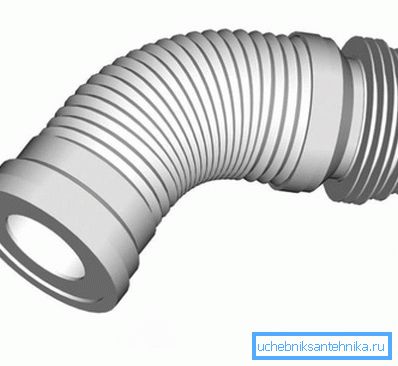
Corrugated
Corrugated bend is a flexible adapter with folded texture. In fact, it is a corrugation with a pipe. Like any other type of connecting elements, this part provides the connection of the outlet of the sanitary device with the socket of the sewer pipe.
I must say that inside the corrugations there is a smooth pipe, the standard diameter of which is 75 mm. The length of the product can be different, it usually varies in the range of 231-500 mm. As mentioned above, the length is selected individually and depends on the location of the plumbing fixture and other connection conditions.
Corrugation is used when it is not possible to perform a rigid connection from the selected position.
Most often this happens in the following cases:
- If you need to make a connection with a small axial displacement relative to the sewer pipe. This is often the case when tile floors are laid on the floor, which leads to equipment lifting. Accordingly, to perform a hard installation in this case will not work.
- In the course of a slight transfer of sanitary device to a more convenient place.
- If the socket is made under the oblique protrusion, and the equipment is intended for smooth connection.
Note!
When choosing a corrugated outlet, it should be taken into account that the corrugation is reinforced and not reinforced. The price of reinforced products is higher, however, they are more durable and durable.
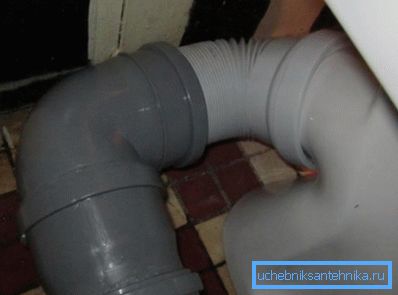
I must say that corrugated pipes are often used when connecting plumbing, as they have the following advantages:
- Connection can be made to the sewer pipe made of any material.
- Allows you to install any type of toilet.
- Easy installation, so you can do the job even with your own hands.
However, it should be borne in mind that this product is not always a suitable option, since it has quite a few shortcomings:
- Low durability and sensitivity to mechanical stress.
- Ability to use only on open areas.
- At large angles of rotation sagging occurs, which leads to frequent blockages of this area.
Thus, the use of corrugations is justified only in cases where it is really necessary.
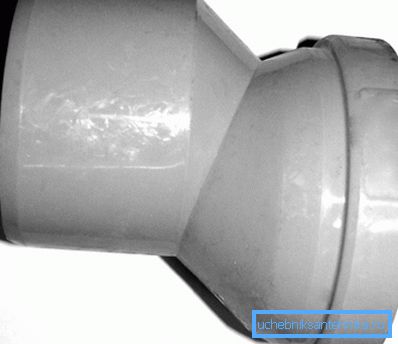
Eccentric adapter
This connecting element is a cuff made of two cylinders, which are tightly interconnected, but their longitudinal axes are displaced relative to each other.
Eccentricity is necessary in cases when the outlet of the toilet bowl does not coincide in height with the spout pipe.
On sale there are two types of such products:
- For long connections;
- For short connection.
Unlike corrugations, solid eccentric adapters have the following advantages:
- Able to withstand mechanical stress. Thanks to this, in case of blockages, the sewage system can be cleaned without fear of sanitary plumbing.
- Less exposed to high temperatures, so the system can be washed with boiling water to prevent blockages.
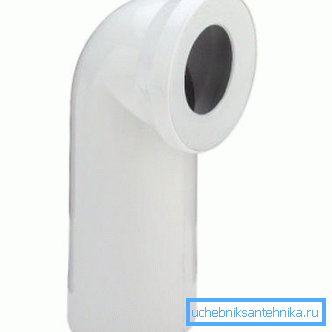
Hard plastic pipe
A rigid toilet pipe is a rigid plastic pipe that has rubber cuffs at the edges to ensure a tight connection. The product can be both equal, and bent.
Angular bent adapters are available:
- 45 degrees;
- 90 degrees.
Plastic product provides a rigid fixation. Its main advantage, in addition to mechanical strength, is the lack of a tendency to the occurrence of blockages (in the absence of drawing areas with a horizontal plane). However, they can be used only in cases where the location of the sanitary appliance and the sewer socket are fully consistent with the bend angle of the nozzle.
Here, in fact, all the main types of tap-off adapters that are used when connecting toilets.
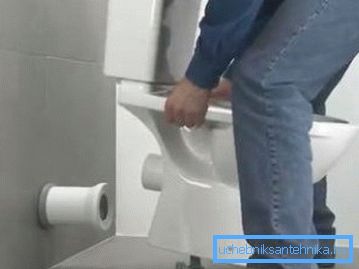
Connection pipe
A brief instruction on connecting a corrugated adapter is as follows:
- The first rubber seal should be put on the toilet exit. To make it easier to put on, it should be moistened with water.
- Then the toilet is installed in place.
- The second end of the drain dock with the sewer bell.
Note! To seal all joints, it is necessary to coat them with silicone sealant.
If the connection is made with rigid connecting elements, then it is a little more difficult to perform, as it may be necessary to move the plumbing device to the required distance. If you need any complex non-standard solutions, and you still do not have the proper experience, it is better to seek help from a professional plumber.
Conclusion
A drain is an important element for connecting a toilet bowl, on which not only the tightness of the system depends, but also the absence of blockages during operation. Therefore, the choice and installation of this element must be approached correctly, given the above information.
From the video in this article you can learn more about this topic.